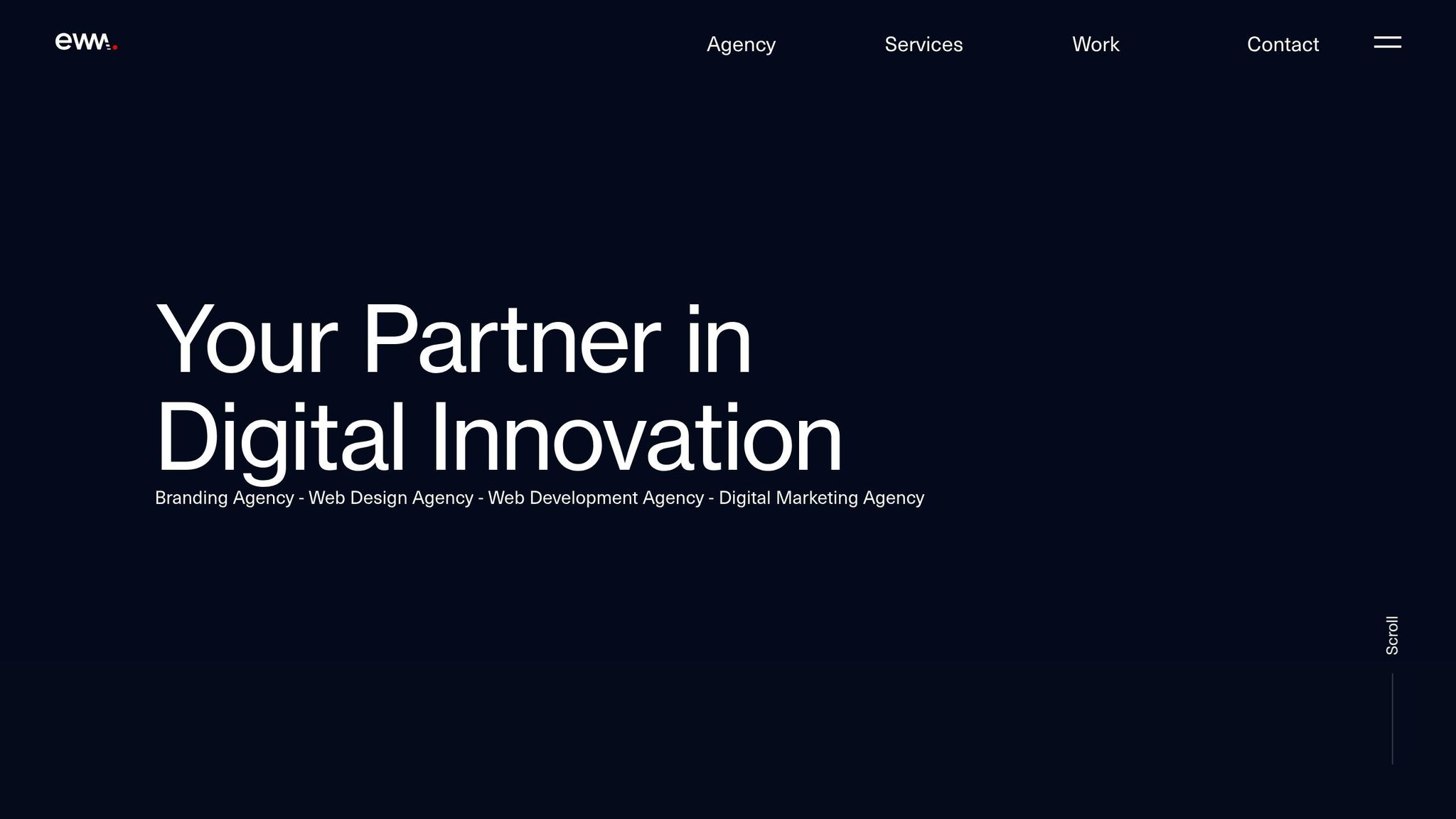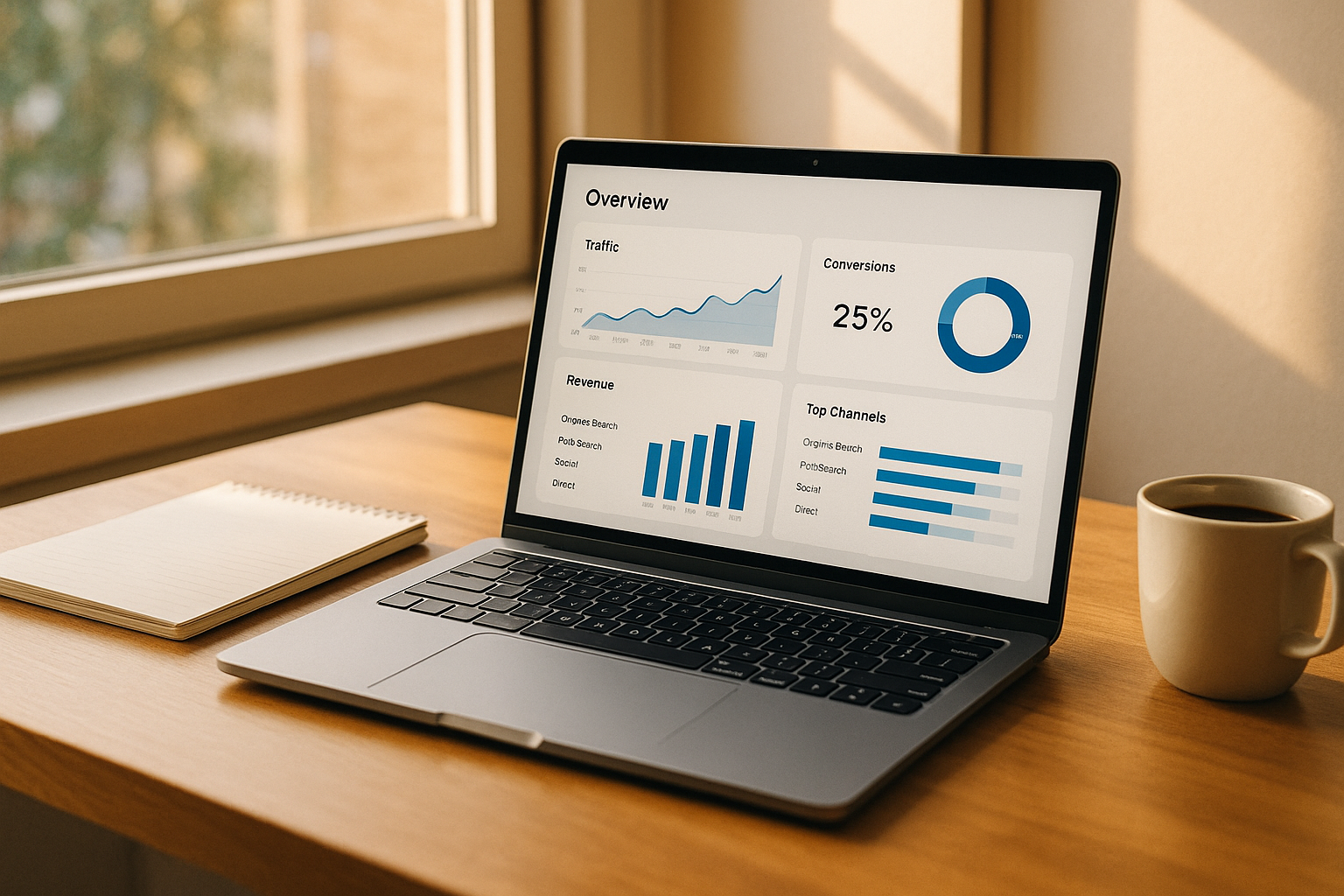Digital marketing ROI: measure real performance
Digital Marketing ROI: Measuring Real Performance
Measuring the ROI of digital marketing is essential today to ensure that every franc invested generates measurable results. Thanks to the traceability offered by digital tools, it is possible to track performance in real time, optimize campaigns, and maximize their effectiveness. However, many challenges remain, including data fragmentation, complex conversion attribution, and legal constraints related to Switzerland.
Key points to remember:
- Definition of ROI: Simple calculation: (Generated revenue - Marketing costs) / Marketing costs × 100.
- Common issues: Dispersed data, non-linear customer journey, and the impact of the GDPR (General Data Protection Regulation).
- Practical solutions:
- Set clear objectives using the .
- for precise campaign tracking.
- Differentiate direct and indirect costs for a more realistic analysis.
- Swiss specificities: Multilingualism, high consumer expectations, and adaptation to new regulations.
By collaborating with experts like , can overcome these obstacles and transform their marketing efforts into measurable and sustainable growth.
Which KPIs to follow to measure the ROI of your marketing campaigns?
Setting Clear Objectives
To effectively evaluate ROI, it is essential to start by setting precise objectives that will guide your efforts and allow you to .
Adopting the SMART method for your objectives
The SMART method transforms general intentions into concrete and measurable objectives. Each objective must meet five criteria: it must be Specific, Measurable, Achievable, Realistic, and Time-bound [1]. This method provides a clear structure to plan your actions and evaluate their impact.
By following these principles, you establish the foundations of a marketing strategy based on tangible and measurable results. This also facilitates precise data collection, an essential step for analyzing and for a better ROI.
Data Collection and Analysis to Measure ROI
To evaluate the effectiveness of your marketing campaigns, it is essential to link each action directly to the results obtained. A simple and powerful method to achieve this is the use of , which transform your links into real tracking tools. Let's see how to integrate these parameters into tracking your campaigns.
Using UTM Parameters for Campaign Tracking
UTM parameters, added to your URLs, allow you to precisely identify the source, medium, and content that generate traffic and conversions. Here are the main elements of a typical UTM structure:
- utm_source: Indicates the traffic source (e.g., "newsletter").
- utm_medium: Designates the type of medium used (e.g., "email").
- utm_campaign: The campaign name (e.g., "fall_offer_2025").
- utm_term: The keywords used (useful for paid advertising campaigns).
- utm_content: Allows distinguishing different variants of the same content.
Let's take a concrete example: for an email campaign promoting a special offer, the URL could be constructed as follows:
www.yourwebsite.com?utm_source=newsletter&utm_medium=email&utm_campaign=fall_offer_2025&utm_content=main_button
Using a for your UTM parameters is essential. This ensures clear and actionable data, allowing you to directly link your campaign's performance to its contribution to ROI.
sbb-itb-454261f
Calculating ROI and Improving Campaigns
Transform your data into actionable insights to optimize your marketing investments and increase the profitability of your campaigns.
The formula for calculating ROI
To evaluate the performance of your campaigns, apply this simple formula:
ROI = (Generated revenue - Campaign costs) / Campaign costs × 100
It expresses, in percentage, the profitability of your actions.
Let's take an example: imagine that your company in Switzerland invests CHF 5,000 in a Google Ads campaign targeting the Romandy market, and this campaign generates CHF 18,000 in revenue. The calculation would be: (18,000 - 5,000) / 5,000 × 100. This result shows how much each franc invested can multiply its return.
For a more precise analysis, it is essential to differentiate direct and indirect costs. Direct costs include advertising expenses, marketing tool fees, and content creation. Indirect costs, on the other hand, encompass team time, training, or software depreciation. By considering these two categories, you get a more realistic view of the profitability of your campaigns.
Understanding ROI Results
Once the ROI is calculated, it is crucial to interpret the figures in their context. A positive ROI indicates that the campaign generates more than it costs. However, this result must be viewed in relation to your objectives. For example, a campaign aimed at increasing awareness may show a modest ROI in the short term but generate lasting benefits. Conversely, a flash promotion may produce a quick high ROI without ensuring customer loyalty.
Performance analysis by marketing channel can also reveal significant differences. For example, email marketing may prove more profitable than social media ads. Furthermore, segmenting your audience helps identify which groups – such as existing customers or prospects – offer the best returns.
Optimizing Campaigns with ROI Data
The data from ROI calculation should serve as the basis for adjusting your strategies. Reallocate your budget, improve targeting, and refine your creatives based on the performance of each channel.
Detailed analysis by segment helps refine your personas and focus your efforts on the most profitable audiences. If certain ads outperform others, identify key elements – such as visuals, messages, or calls to action – to create even more effective content.
Consistency in analysis is essential. Adjust the frequency of your optimizations to the cycle of your campaigns to quickly identify trends and adjust your actions.
Finally, automation can simplify the process. Set up automatic rules to increase the budget for high-performing campaigns and reduce it for less effective ones. This approach allows you to maximize your results while saving time, a strategy particularly relevant for .
Specific Considerations for the Swiss Market in Digital Marketing ROI
For , it is essential to consider local specificities. Here's how to adjust your strategies to meet the unique expectations of this market.
Multilingual Campaigns and Local Preferences
With its four national languages (German, French, Italian, and Romansh), Switzerland requires precise segmentation of marketing campaigns to effectively reach each linguistic group. Swiss consumers, known for their high level of education, particularly value quality, precision, and transparency in communications.
The country has an internet penetration rate of over 95% [2], opening up vast opportunities for digital marketing. are experiencing growing success, even among older age groups: 40% of users TikTok users aged 45 and over watch short video ads weekly [2]. Additionally, in Swiss influencer marketing, authenticity often prevails over fame. Nano-influencers (10,000 to 100,000 followers) generally generate better engagement than celebrities [2][3], while offering a more affordable cost, enhancing campaign effectiveness.
However, these strategies must be implemented within a strict regulatory framework, as explained below.
Compliance with Data Protection in Switzerland
Data collection and analysis for marketing purposes in Switzerland are directly influenced by the . The , effective from September 2023, imposes increased requirements regarding consent and transparency. These rules sometimes limit user tracking capabilities, which can affect the accuracy of ROI measurements.
Complying with the GDPR requires . These costs must be integrated into your profitability calculations. However, by adopting first-party data collection solutions, you not only enhance consumer trust but also reduce financial risks associated with potential regulatory breaches.
In this complex context, let's see how EWM SA can help businesses overcome these challenges.
How helps Swiss companies maximize their ROI

EWM SA, with offices in Geneva, Zurich, Paris, London, and Nice, understands the subtleties of the Swiss market. The agency helps companies optimize their digital marketing ROI while respecting local specificities.
With a seamless bilingual approach in French and German, EWM SA designs campaigns tailored to regional preferences, resulting in higher conversion rates and reduced acquisition costs. This linguistic and regional expertise aligns messages with the expectations of different Swiss audiences.
Moreover, the agency integrates compliance requirements related to the GDPR from the outset, thus avoiding unforeseen costs associated with post-adjustments. With its custom web development and bilingual SEO skills, EWM SA enhances the technical performance of digital platforms, providing an optimized user experience and increasing return on investment.
Finally, EWM SA supports companies in implementing analytics tools tailored to the Swiss market. By using compliant data collection strategies, the agency ensures reliable information, enabling continuous adjustment and optimization of your marketing investments.
Conclusion: Transforming Data into ROI Insights
Success relies on SMART objectives that define KPIs aligned with your business priorities [4][1].
By consolidating data from multiple sources, you gain an overview of touchpoints along the customer journey [4][1]. This holistic view allows for accurately attributing conversions to different marketing touchpoints and identifying additional sales generated by your campaigns. These elements form a solid basis for analyzing your performance and adjusting your strategies.
Data analysis should be based on a : formulating hypotheses, testing them, and drawing concrete conclusions [5]. With this methodology, you can optimize your campaigns with A/B tests, and adapt your strategy in the long term.
For Swiss companies, these challenges are even more complex due to local specificities: campaigns tailored to multilingualism, compliance with the GDPR, and high consumer expectations regarding quality. EWM SA, with its expertise gained since 2011 and its offices in Geneva, Zurich, Paris, London, and Nice, helps companies navigate this digital transformation. Their support aims to maximize ROI while addressing the peculiarities of the Swiss market.
Digital ROI is not an end but a process of continuous improvement. By centralizing your data and rigorously analyzing each channel, every Swiss franc invested becomes a driver of measurable and sustainable growth. This strategic approach transforms your digital efforts into tangible and lasting results.
FAQs
What impacts does the new Federal Act on Data Protection (nLPD) have on performance tracking in digital marketing in Switzerland?
Switzerland recently introduced the new Federal Act on Data Protection (nLPD), which strengthens rules regarding the collection, processing, and storage of personal data. These changes directly impact digital marketing, especially on the use of analytics tools and data-driven campaigns.
To comply with this law, obtaining explicit user consent is now essential before any data collection, whether through cookies or forms. Companies must also ensure data is securely stored and respect user rights, such as allowing access to and deletion of their information upon request.
Additionally, using analytics solutions compatible with the nLPD and working exclusively with partners who adhere to Swiss privacy standards is advisable. These measures are not only a legal obligation but also build user trust in companies.
How can UTM parameters help me measure the ROI of my digital marketing campaigns?
UTM (Urchin Tracking Module) parameters are tags added to URLs to accurately track the performance of your marketing campaigns. They enable the analysis of essential data such as traffic source, conversion rates, and visitor behaviors on your site.
By using these parameters in your links, you can determine which campaigns yield the most results, calculate , and better understand the . This information helps you allocate your budgets more effectively and focus your efforts on the most profitable actions.
How to optimize your digital marketing campaigns to maximize ROI in Switzerland, a multilingual market?
To make the most of your digital marketing campaigns in Switzerland, it is essential to consider the linguistic and local specificities of the market. Here are some recommendations to optimize your results:
- Adapt your messages to the main languages spoken in Switzerland: French, German, Italian, and, in some cases, English. This ensures more relevant and effective communication with your diverse audiences.
- Comply with Swiss data protection laws, especially regarding privacy and handling of personal information. Adhere to local standards to avoid legal issues.
